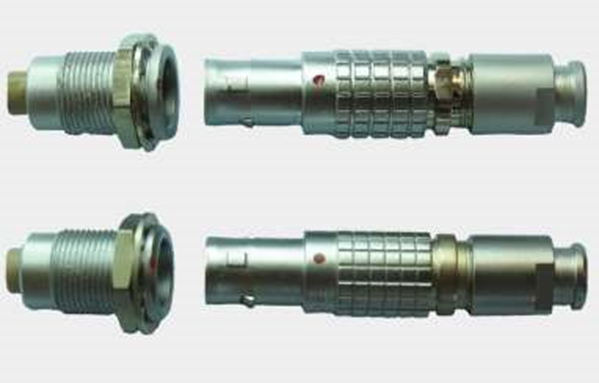Counterfeit Connectors: A Matter of Life and Death in the Medical Device Industry
It’s imperative that medical device manufacturers use authentic connectors. Counterfeit connectors and other fake components can pose serious risks to patients, providers, and companies.

The counterfeit connector on the left attempted to imitate the look and feel of the authentic LEMO Redel connector on the right, but deformed and failed under normal operating conditions for the real deal. In medical applications, a counterfeit like this could spell disaster, or even death.
Counterfeit connectors are always a problem. When they are used in medical devices, they can pose a serious risk of harm or even death to the patients who use them. Outfitting medical devices with counterfeit connectors can lead to faulty performance, degraded materials, and electrical shorts. Substituting inferior materials may even cause the failure of mission-critical products, such as smart medical devices or implants. In such situations, the use of counterfeit connectors can result in painful and costly legal issues, such as failure to meet warranties or service contracts, or litigation for personal harm or injury. In these situations, counterfeit connectors can ultimately contribute to damage a device manufacture’s brand.
“Counterfeiting is on the rise in the medical device industry and we take this threat very seriously,” said Steven Lassen, senior customer application engineer for LEMO USA.
When a counterfeit connector is substituted, knowingly or unknowingly, for an approved authentic connector, the reliability and quality of the connector — and therefore the device — is considered compromised, even if the switch reflects only small changes in materials, platings, or strength of the connector.
“A common problem for rugged connectors might be the so-called ‘equivalent’ connector, where an off-brand makes a copycat product that claims to mate with a certain branded product,” said David Cianciolo, director of engineering for Fischer Connectors. “We’ve seen this happen before with negative results for the device manufacturer.”
Why Medical Device Companies Use Counterfeit Connectors
The medical device industry is very competitive and device manufacturers are always looking for cost advantages. Some will seek out lower-cost products for a slight savings, which are often counterfeited copycats. “Cost savings is usually the main driver,” said Lassen, “but the unknown risks down the road leading to potential product recalls or unforeseen failure modes easily outweigh any initial cost savings.”
Counterfeiters may resemble legitimate component manufacturers or distributors, with websites that appear to be reputable companies. Most copycat components are manufactured in Asia. It can be very difficult to identify counterfeit products. They may appear identical to authentic parts and some counterfeiters even use the same part numbers as the original manufacturer.
When a medical device company outsources cable assemblies, and a subcontractor gets involved, due diligence is absolutely required. “If they don’t ask the right questions, the company may not be getting the same quality product that passed FDA inspection,” said Cianciolo.
When Medical Devices Go Bad
Knock-off connectors can cause medical devices to malfunction, which may put medical personnel and patients at risk. Counterfeiters usually do not have access to the original manufacturer’s tolerances, so when they replicate the item, it will likely not function as intended in the overall system. For example, electrical connector failure can be related to inferior electroplating. Components that have not been deburred properly can experience shorts, solderability, or mismating issues when a burr breaks or when more material is removed in the deburring process than is necessary, altering the geometry of the part. “A good example is the mechanical alignment keying of an original receptacle, mated with a counterfeit plug,” said Lassen. “The plug was inserted without regard to the keyway, allowing the electrical contacts to engage with the incorrect pins.”
Although counterfeit mishaps will impact brand reputation, the greatest worry for many connector suppliers is impact to the patient.
“Our connectors are used in critical, life-saving situations, and if a plug fails because it wasn’t built to Fischer standards, the patient is at risk,” said Cianciolo. “This is our biggest worry and the biggest concern for the device manufacturers.”
Battling Connector Counterfeiters
So far, no formal partnerships exist among connector manufacturers to combat counterfeit and copying issues. Therefore, each connector supplier must be proactive in devising ways to protect its products, customers, and end-users from counterfeit products.
The most common anti-counterfeit tool is the use of ‘smart’ connectors, which incorporate circuitry designed to identify original products. “Unless the proper code is read, the device will not function,” said Lassen.
LEMO USA has published a white paper on counterfeit connector products that emphasizes the serious problems posed by these fakes. “Unwitting use of counterfeit components in an otherwise quality product could lead to accelerated equipment failure or malfunction, or to deficits in the performance of the particular end product, or even have life or death implications,” LEMO said.
Cianciolo advises device makers to maintain tight control of all source control drawings. “Do not use spec control drawings with your contract manufacturers,” he said. “Monitor your supply chain closely with regards to cable assemblies and ask all the right questions beyond, ‘Will it mate?’”

Image on top is counterfeit and bottom is authentic. Note on the counterfeit connector the red dot is out of alignment and the finish is inferior.
Like this article? Check out our other Connector Basics articles, our 2019 Article Archive, the counterfeit connector article linked below, and our Medical Market Page.
- Creating Ideal Connectors for Rugged Conditions - January 9, 2020
- Rugged Connectors Expand into New Applications - September 10, 2019
- Counterfeit Connectors: A Matter of Life and Death in the Medical Device Industry - April 23, 2019





